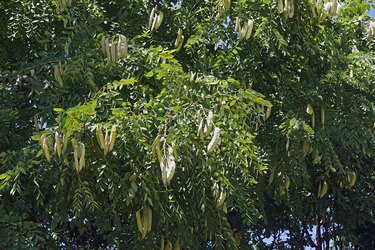
The seeds of trees develop in myriad forms, from the "naked-seed" cone of gymnosperms to the true fruits and pomes of many flowering plants, or angiosperms. In reference to trees, a seedpod usually describes the seed-bearing structure of species in the legume family (Fabaceae). Identifying the specific kind of tree from its seedpod alone can be challenging, but the exercise can be particularly rewarding when used in cross-reference with other physical and ecological characteristics.
Look at the Shape of the Seedpod
Video of the Day
Consider the seedpod's shape, first and foremost. In North America, many native or naturalized legumous trees produce long, slender, curved pods roughly resembling those of the pea plant (also in the family). Trees of this type include the eastern redbud, native to much of the East, and the black locust, indigenous to the Southeast but now widely invasive across much of the country.
Video of the Day
There are many variations: The velvet mesquite of Southwestern washes and arroyos tends to grow an extremely narrow seedpod such that the fleshy covering bulges over each seed and tapers between, giving the structure a beaded-necklace look. Other native mesquites conceal their seeds in similar beaded pods.
The pods of the Kentucky coffeetree, a bottomland legume of the Central Lowlands, are much stockier than most others in North America, resembling less a beanpod than a mahogany fruit (and, indeed, another name for this tree is the Kentucky mahogany). American Indians and Euro-Americans alike roasted Kentucky coffeetree "beans." Other legumes, notably the catclaw acacia of the deep Southwest, produce slender but wildly twisted pods.
Consider the Size of the Seedpod
Gauge the seedpod's size. Much variation exists in this characteristic, as well. The burly pod of the Kentucky coffeetree may be 5 or 10 inches long and a couple of inches across. The elegant, elongate pods of the littleleaf leucaena of West Texas buttes and uplands may be 8 inches long. Compare this with the inch-long, rattle-like seedpods of the aptly named screwbean mesquire of desert drainages in the Southwest, or the similarly stunted teardrop-shaped growths of the waterlocust of Southern swamp woods.
Examine the Adult Tree
Consider these traits of the seedpod in the context of other features of the tree. If you find a pod on the ground, chances are you'll be able to track down the source in the vicinity, so you'll rarely be attempting identification from fruit alone. The vast majority of legumous trees have alternate, pinnately compound trees, which give their canopies a striking, layered, delicate appearance. Examine the leaf shape – rounded or slender, pointed or rounded – as well as other salient aspects like bark, size and bloom (if the tree is flowering, of course).
And don't disregard ecological and geographic aspects: Use a tree field guide with distribution maps and habitat characteristics to narrow down your likely candidates. Keep in mind, though, that some legumes are widely planted or naturalized outside their "native" (usually considered to be pre-European) range.